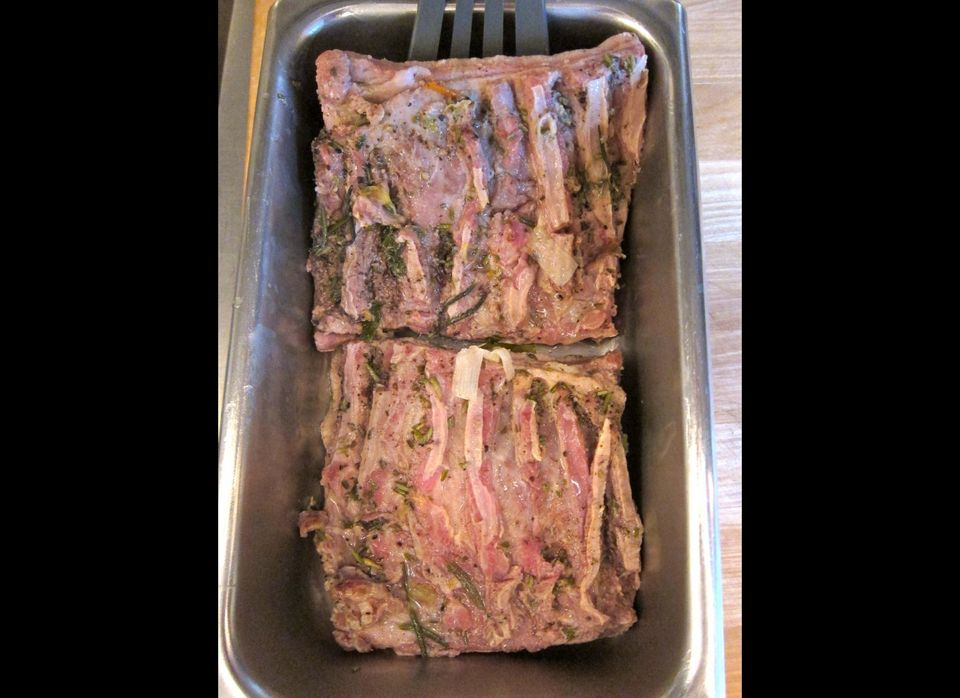Yes, I know: Lovers of pure language say that there's no such word as crispy (as opposed to crisp) except in the special vocabulary of menu-, advertising- and recipe-writing. I agree with them; it's a term I avoid. But even non-words can convey something, in this case the command, "Order Me!" And Jackie and I obeyed on a recent visit to London, when we had dinner at a Chinese restaurant half-way up the tallest building in Europe: Hutong at The Shard. What we got was called Crispy De-Boned Lamb Ribs (i.e. the thin part of breast of lamb), and it was served with a dipping sauce and do-it-yourself toppings of minced garlic and shredded scallions. The dish took us back to our first trip to Hong Kong, in 1989, when we had a similar thing at Spring Deer restaurant, which is still in business; there it was served à la Peking duck, with pancakes, hoisin-based sauce and all the trimmings.
What is this crisp breast of lamb? The meat is seasoned or marinated, simmered or braised until tender, boned, cooled, then deep fried and cut into strips for serving (at Spring Deer they gave it an extra steaming before frying). It's a wonderful thing: all the stick-to-your-lips gelatinous unctuousness of breast of lamb, with a crunchy surface. And despite the succession of steps, it isn't difficult to make at home, or, as I did the other day, to use the cooking technique to make two entirely different dishes with similar qualities.
In the past, I've used Chinese flavors to mimic the Hong Kong version, simmering the lamb in a liquid scented with star anise (or five-spice powder), ginger, garlic, scallions and soy, then rubbing it with a five-spice mixture and serving it in that Peking duck fashion: unbelievable fun to eat. I've also Mexicanized it and used the crisp lamb as a taco filling: This too makes Jackie and me giggle with pleasure.
But this time, I kept the flavors and the outcomes European for a change of pace. I removed the bones from two small pieces of lamb "spareribs," each about eight inches square, then browned the bones plus some vegetables and herbs and used a pressure cooker to make lamb stock. I find it simpler and neater to bone the lamb and make the stock beforehand, though it is an easy enough task to pull the bones from the simmered meat once it has cooled enough to handle: the order of battle is up to you. I put the lamb and stock into a pan with leeks (onions would be fine), carrots, celery, rosemary, parsley and salt and pepper, and simmered very gently until the meat was tender, just over an hour in this case. I let it cool part way in the cooking liquid, then removed the lamb to a tray and stacked the two pieces with plastic wrap and a weight on top to ensure a neat result. This went into the fridge until needed. I strained and cooled the newly enriched stock, removing the congealed fat from the top when it had chilled.
The two pieces of lamb had differing destinies on successive days. One I rubbed with smoked Spanish paprika (pimentón), finely minced rosemary and salt and pepper - lots of each -- dredged in cornstarch and fried in about 3/4 inch (2cm) of neutral oil at about 330 degrees F (165 C). The moderate temperature gave the meat plenty of time to heat through as the outside browned. I cut it into fingers (halved across where the ribs had been, then cut parallel to the former rib-lines) and served it with parsnip puree (peeled and chunked parsnips simmered in milk then food-processed with butter and some of that milk) and lamb gravy saved from a previous stew; if I hadn't had any gravy, I might have made a quick butter-thickened sauce from the lamb stock or used a simple bright-tasting sauce like the one I'm about to describe.
For the other dish - a company's-coming first course of some elegance -- I first made that sauce. For four modest portions, I reduced a cup or so of the reserved lamb-simmering liquid with a sprig of rosemary until it started to get syrupy; it now amounted to about a quarter cup. I strained it into a bowl and, when it had cooled a bit, whisked in a good tablespoon of Dijon mustard and a generous teaspoon of excellent cider vinegar, then as much olive oil as it took to form a viscous, pourable emulsion. I also roasted a couple of carrots in the way Neil Borthwick of London's Merchants Tavern taught me (Mark Bittman has described Mr. Borthwick's technique, so I don't need to).
This time, I cut the lamb into fingers before frying to make a neater presentation and create even more crunch. I seasoned it simply with salt, pepper and rosemary, then dredged it in cornstarch and fried it as I had for the other dish. On each plate I arranged a length of carrot cut in half on the bias and three fingers of lamb, then drizzled room-temperature mustard sauce over all.
On the one hand, these two dishes couldn't have been more different from their Chinese inspiration, but there's no denying that they all shared one alluring quality: They were crisp. No -- they were more than crisp: they were crispy!
